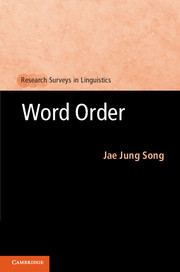Book contents
2 - The Linguistic-Typological approach
Empirical validity and explanation
Published online by Cambridge University Press: 05 June 2012
Summary
Linguistic Typology (LT) can be defined succinctly as the study of structural variation in human language with a view to establishing limits on this variation and seeking explanations for the limits (e.g. Mallinson and Blake 1981; Comrie 1989; Whaley 1997; Song 2001, 2011; Croft 2003). Because LT, more than any other approach, including those surveyed in this book, prioritizes the task of discovering cross-linguistic variation as attested in the world’s languages, the LT approach to word order is chosen justifiably as the first of the main chapters of this book. As explained in Chapter 1, this is intended to ensure that readers have an opportunity to familiarize themselves with what kind (or range) of word-order data to investigate before tackling the remainder of this book. This way, they will be in a better position to appreciate the kind and range of data that different theoretical approaches to word order (do not) address in their respective investigations. Put differently, LT imposes the lower bounds, as it were, on what must be accounted for empirically by all theoretical approaches (to word order). Whatever theoretical imperatives or expediencies may initially have a bearing on the way a given theory is to be developed, the reality of the world’s languages – that is, empirically valid cross-linguistic variation – must eventually be addressed (and also accommodated) by that theory. To wit, data, not theory, will have the final say in the matter. Moreover, LT, as practised today (or since its rebirth in the early 1960s), had its very beginning in none other than word-order research or, more accurately, Greenberg’s (1963) seminal work on word order. Therefore, there is much merit in commencing discussion of word order research with the LT approach.
- Type
- Chapter
- Information
- Word Order , pp. 10 - 71Publisher: Cambridge University PressPrint publication year: 2012



